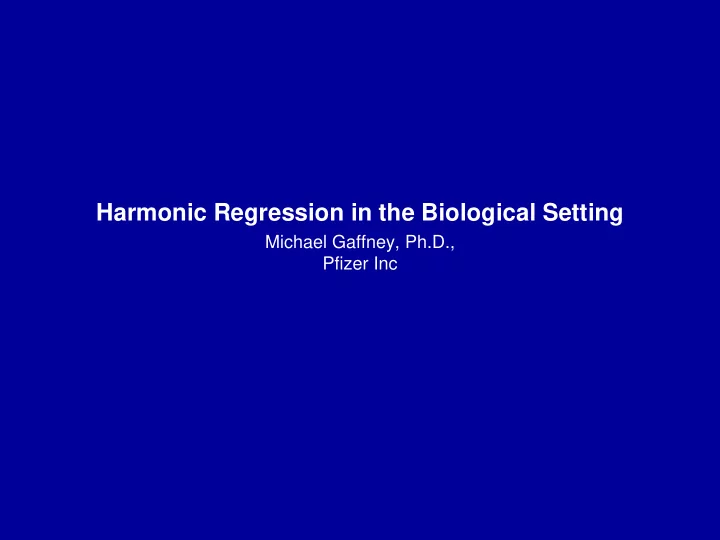

Harmonic Regression in the Biological Setting Michael Gaffney, Ph.D., Pfizer Inc
Two primary aims of harmonic regression 1. To describe the timing (phase) or degree of the diurnal variation (amplitude) of a physiological variable, e.g., blood pressure the amplitude of mean data underestimates the true amplitude unless all subjects are in phase 2. To analyze the treatment effect over a specific time period such as 24 hours in the presence of diurnal variability. harmonic regression analysis yields specific hypotheses that relate directly to the treatment effect over 24 hours.
Two Harmonic Model R it = M i + A 1i Cos (2π t / 24 – T 1i ) + A 2i Cos (2π t / 12 – T 2i ) R it is the response variable for the subject i at hour t t = 1,…,24 M i is the 24 hour mean rate for subject i A 1i and T 1i are the amplitude and peak time of the 24 hour harmonic A 2i and T 2i are the amplitude and peak time of the 12 hour harmonic
Fourier Coefficients 1. R it = M i + A 1i Cos (2π t / 24 – T 1i ) + A 2i Cos (2π t / 12 – T 2i ) An alternative representation is 2. R it = M i + a 1i Cos (2π t / 24 ) + b 1i Sin (2π t / 24 ) + a 2i Cos (2π t / 12 ) + b 2i Sin (2π t / 12 ) Where, a 1i = A 1i Cos T 1i and b 1i = A 1i Sin T 1i 2 + b 1i 2 ) ½ and T 1i = arc tan (b 1i / a 1i ) Consequently, A 1i = ( a 1i
Diurnal Rhythm of Mean Systolic BP in 41 Subjects
Distribution of Peak Times Hour Systolic BP N % 0-4 2 5 4-8 2 5 8-12 12 29% 12-16 8 20% 16-20 13 32% 20-24 4 10% 41
Diurnal Rhythm of Systolic BP in 6 Individual Subjects
Peak-trough difference Subject Estimated* Observed** 1 39.1 38.2 2 35.6 32.7 3 22.8 25.7 4 38.1 37.8 5 33.3 33.1 6 25.0 27.1 Avg 32.3 32.4 The estimated peak-trough difference of the hourly means is 20 mmHg.
Mean of individual subject amplitudes compared to amplitudes of mean hourly measurements Peak-trough difference A1 A2 Estimated Observed S M S M S M Systolic BP 10.5 7.8 6.1 3.3 28.6 16.8 26.0
Conclusions • Mean of the Fourier coefficients = Fourier coefficients of the mean data but Mean of the transformed Fourier coefficients ≠ transformed Fourier coefficients of the mean data • Diurnal rhythm of mean data does not adequately describe the diurnal rhythm of individual patients because individual patient harmonics are not in phase . - Amplitude of mean data underestimates the mean of the amplitudes - Timing of the diurnal rhythm of the mean data does not represent the timing of the diurnal rhythm of individual subjects There is no “average” diurnal curve when subjects are not in phase
Treatment Effect over 24 Hours • The UUI rates at hour t for 3 baseline days were averaged to obtain the baseline UUI rate at hour t • The UUI rates at hour t for 3 on-treatment days were averaged to obtain the treatment UUI rate at hour t • The 5-hour moving average UUI rate at hour t was obtained by ( U t-2 + U t-1 + U t + U t+1 + U t+2 ) / 5
Properties of Moving Average • The moving average transformation improves the harmonic fit of the data. • The moving average is a high frequency filter that will filter out noise and result in a better estimation of low-frequency amplitudes. • The amplitude is reduced after applying a moving average. The peak time is not affected by the moving average transformation. • With respect to inferences regarding treatment effects, the moving average transformation has no effect because the standard deviation of the amplitude is reduced proportionally.
Example: 3-hour Moving Average X t = ( X t-1 + X t + X t+1 ) / 3 is the subject’s transformed measurement at hour t X t = a cos 2π t / 24 + b sin 2π t / 24 Order time from the peak time for each subject, i.e., peak time is 0 for each subject. The harmonic regression on the 3-hour moving average is identical to the average of the original harmonic regression and the harmonic regressions with a time shift of + - 1 hour Time shift 0: a= A b = 0 Time shift 1: Tan 15 o = b* / a* therefore, [ (a*) 2 + (a*Tan 15 o ) 2 ] ½ = a a* = a / (1 + Tan 2 15 o ) ½ Therefore the amplitude of the 3-hour moving average data is: A [ 1 + 2 / (1 + Tan 2 15 o ) ½ ] / 3
Mean Baseline, Treatment and Change in Amplitudes for UUI rate - 5 Hour Moving Average Placebo Active (N=416) (N=443) Variable Mean SD Mean SD Mean (B) 0.151 0.132 0.156 0.132 Mean (T) 0.105 0.125 0.065 0.089 C 0 -0.046 0.107 -0.091 0.095 (p<0.0001) A 1 (B) 0.089 0.064 0.091 0.069 A 1 (T) 0.058 0.057 0.039 0.049 C 1 -0.031 0.065 -0.052 0.062 (p<0.0001) A 2 (B) 0.056 0.039 0.057 0.041 A 2 (T) 0.032 0.029 0.024 0.026 C 2 -0.024 0.037 -0.033 0.039 (p=0.001)
Change from baseline in UUI Rate by Peak time Placebo High Dose Peak Time -0.095 -0.150 (peak hour + - 4 hours) (p<0.0001) Off-Peak -0.017 -0.055 (p<0.0001)
Recommend
More recommend